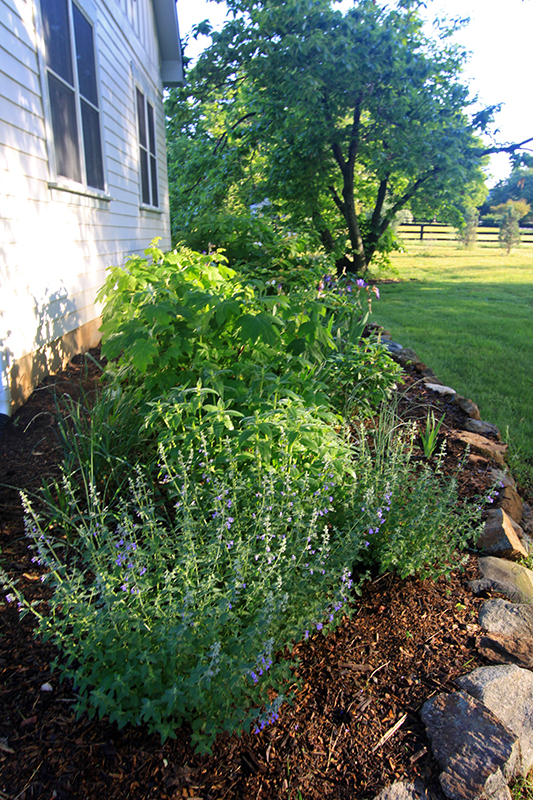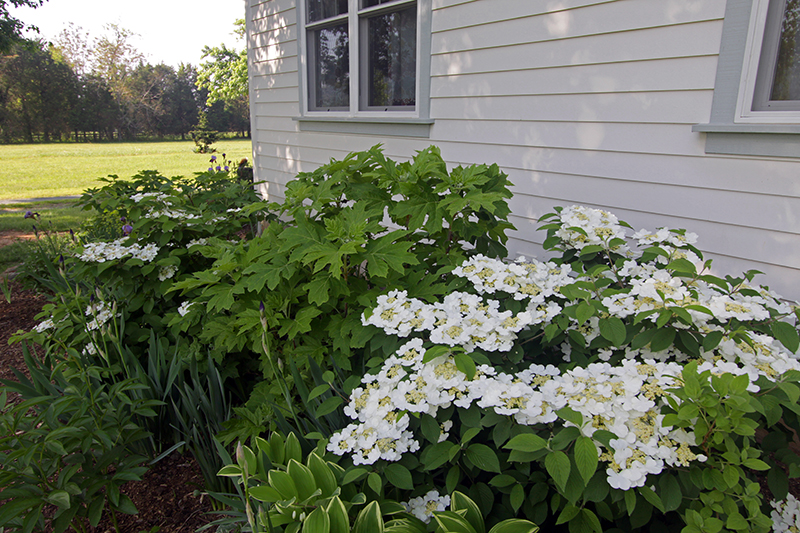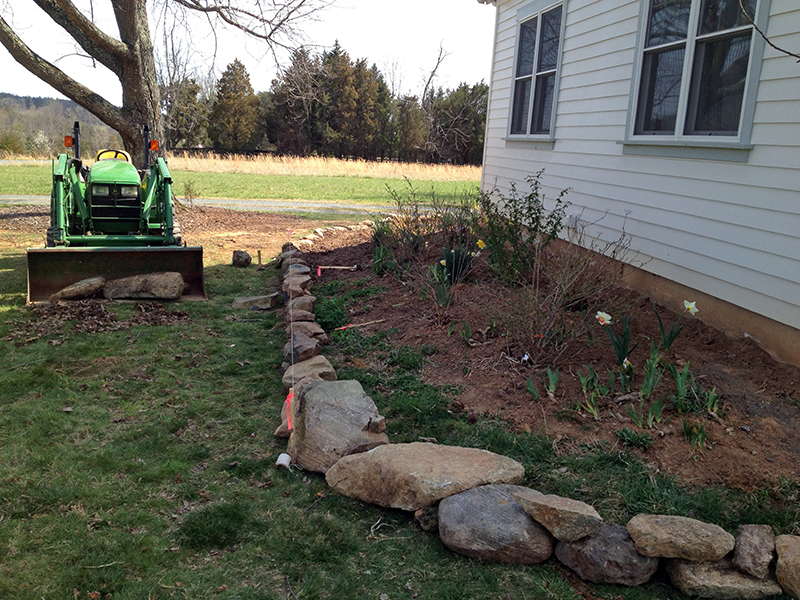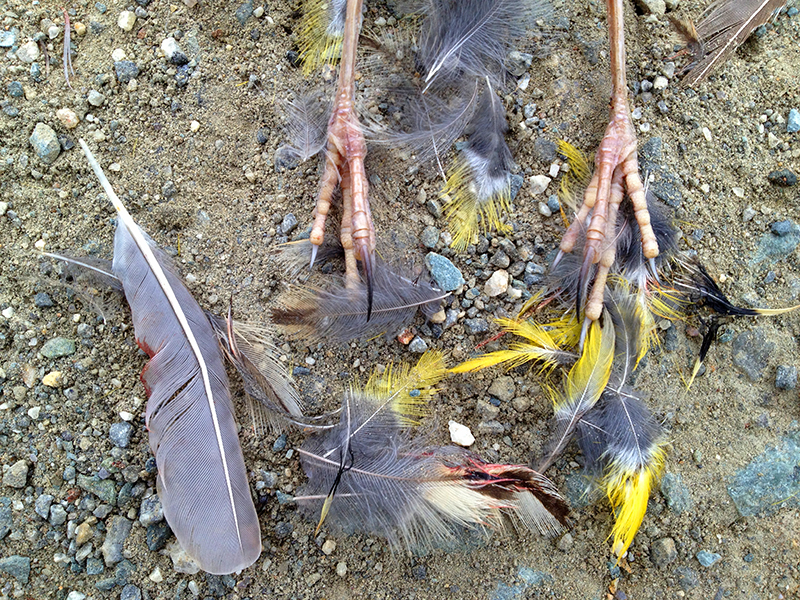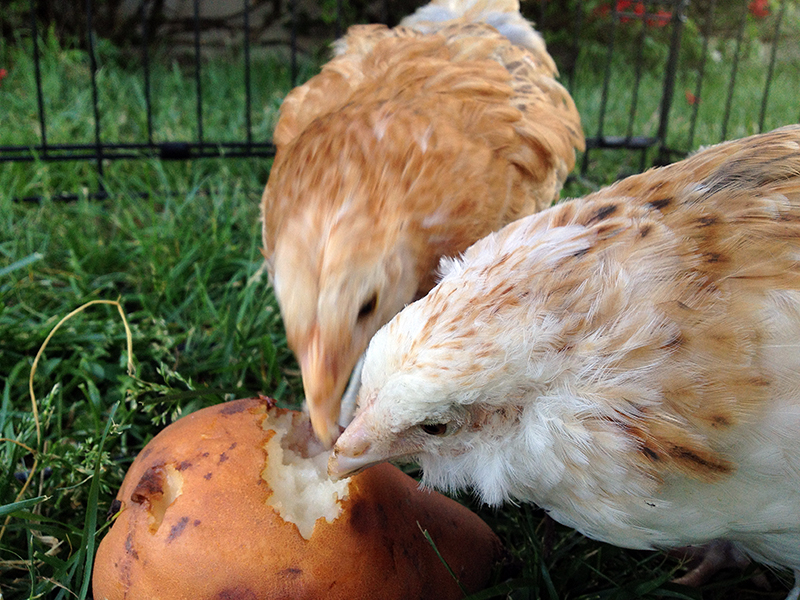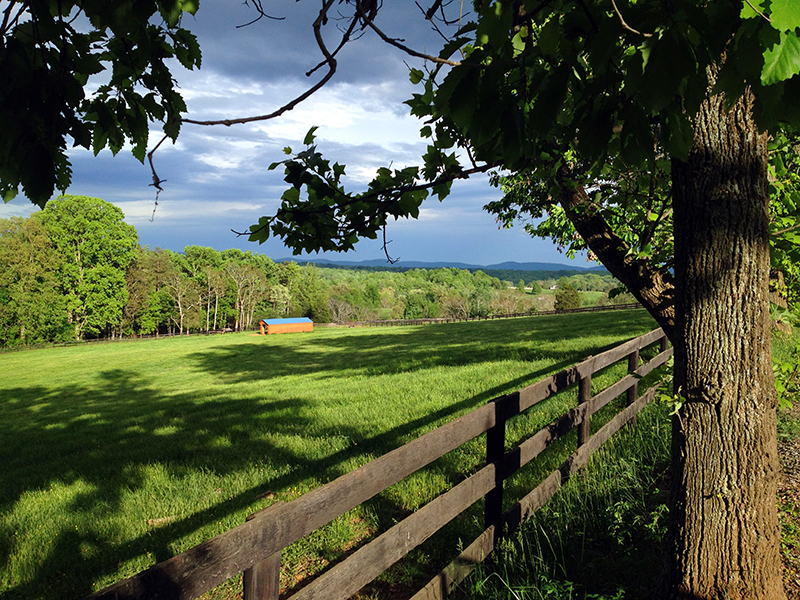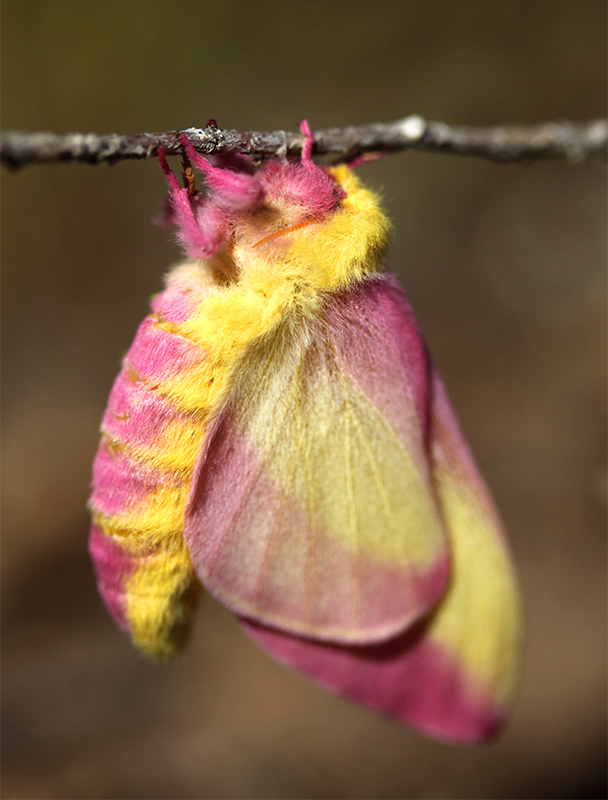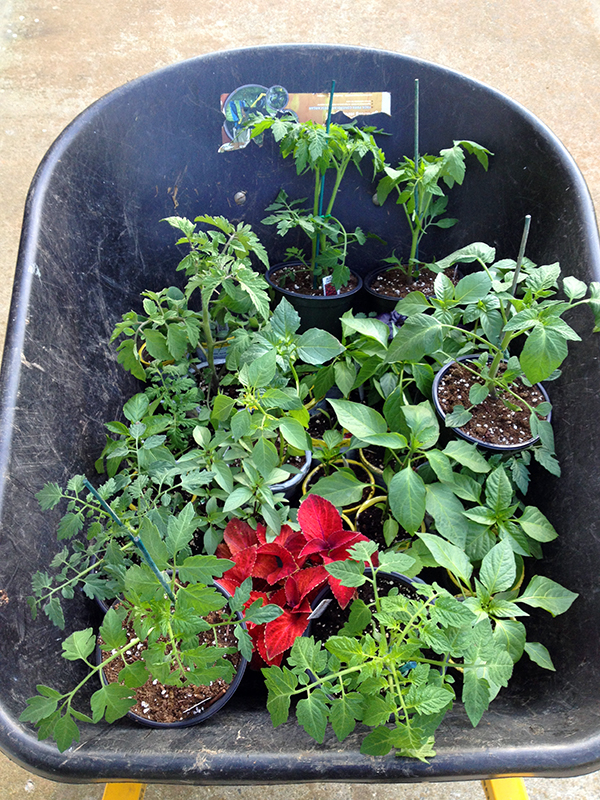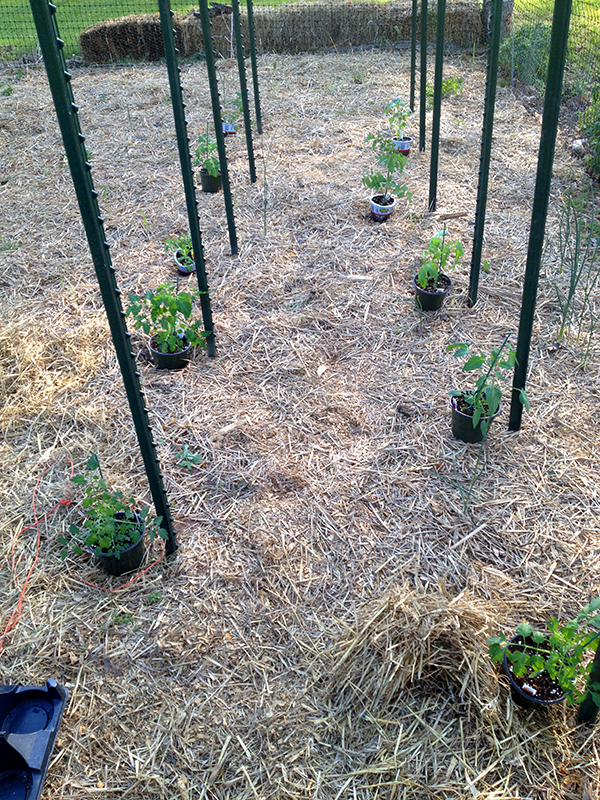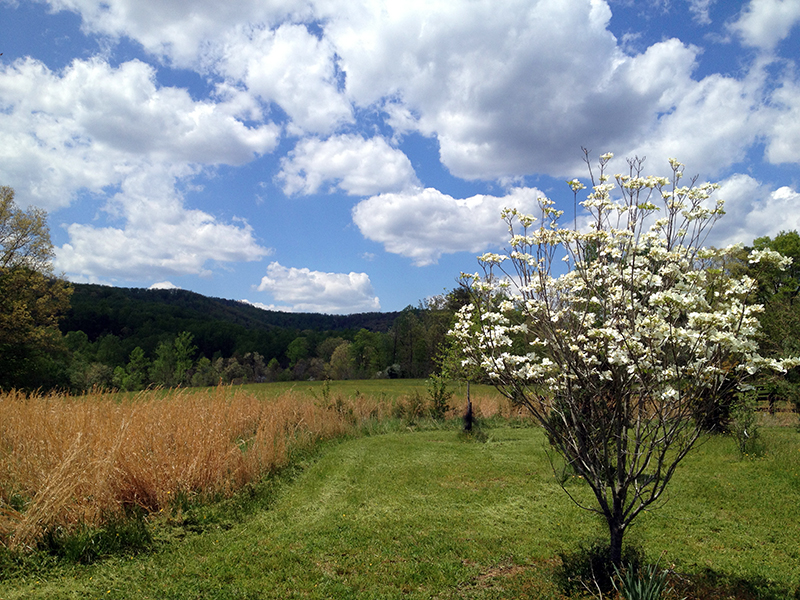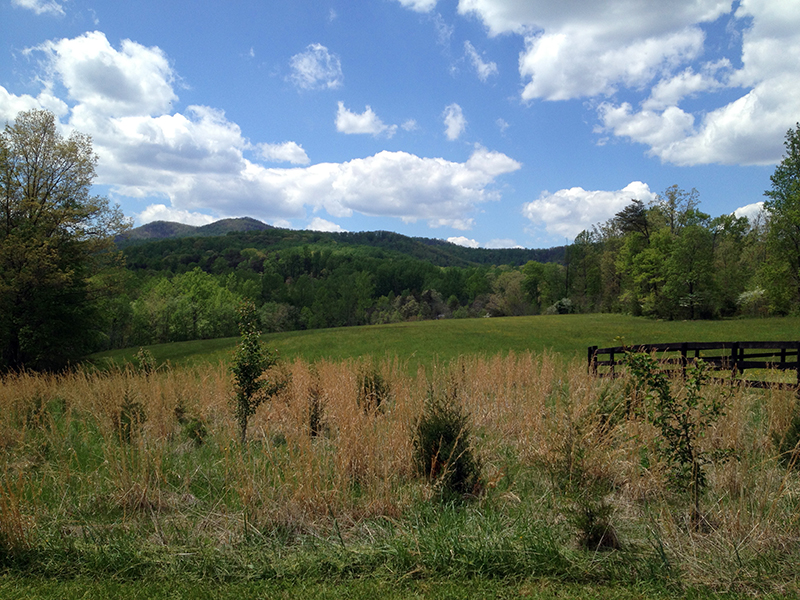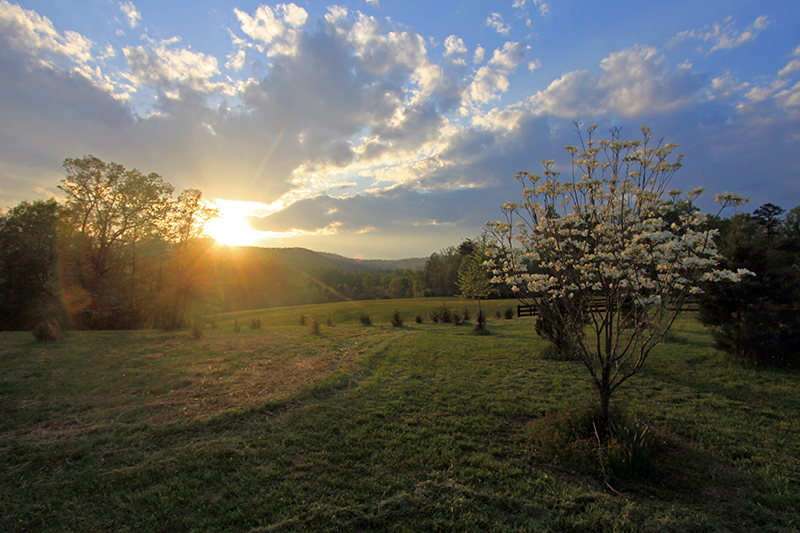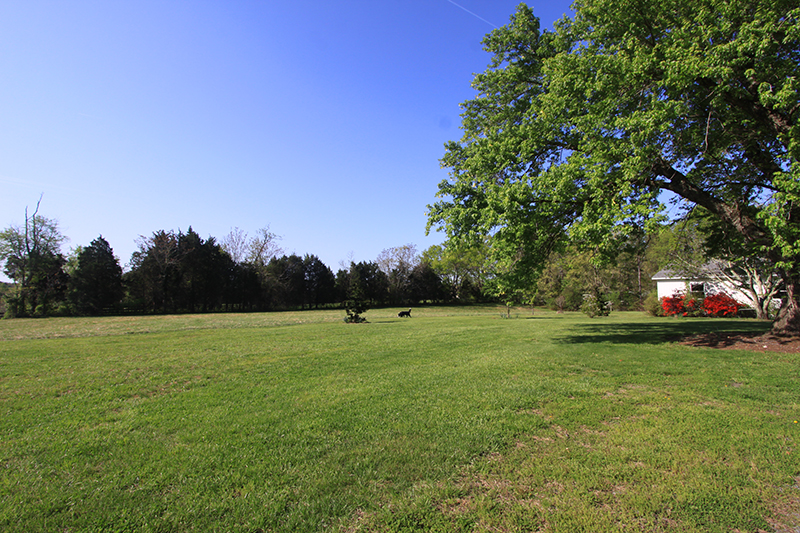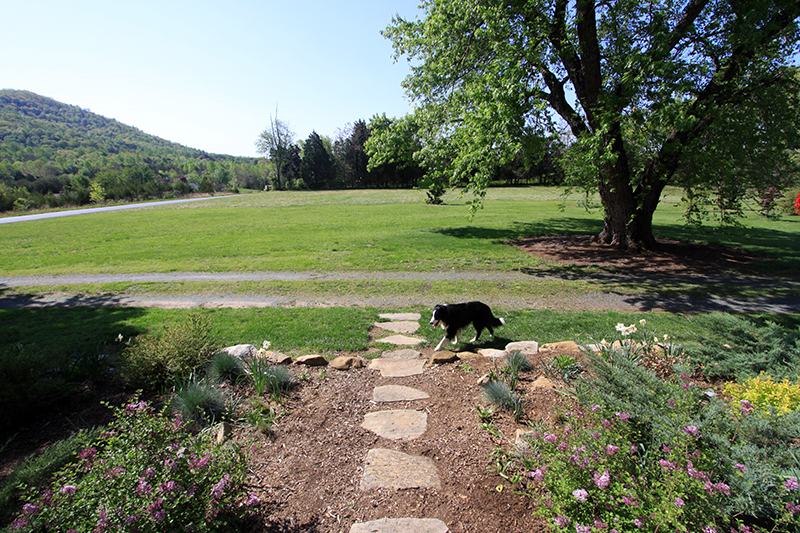Creeps up from the creek and across the field.
The pink mist
May 31st, 2014 § 0
Doing and not doing
May 30th, 2014 § 1
For weeks I’ve been watching a little house wren sit on a tidy nest in a front-garden shrub. I’d found the nest with my spade raised to prise the bush from the ground for relocation. Four blue, brown-speckled eggs popped into view, tucked just inside.
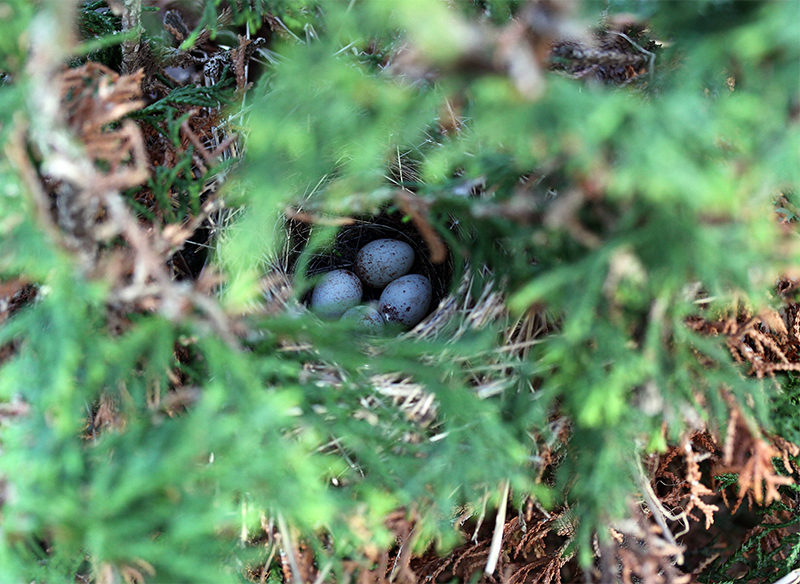
Obviously, landscaping was postponed, and each day I checked on the nest, always expecting the eggs to be gone. They were precariously sited in a bush not two feet off the ground, easy pickings for a snake or raccoon or possum. I considered surrounding the bush with some sort of barrier, but knew that the only thing that would keep a snake out was fine netting. I learned my lesson last summer when a large black snake got stuck and died in the netting I installed to protect the garden from the chickens. So I chose not to intervene with the nest.
Without any “help,” the eggs persisted, and two days ago the mother wren didn’t fly off the nest when I approached. She flattened her body in place, with only her brave eyes moving, and I knew her eggs had hatched.
Yesterday I went out to feed the chickens and saw Tucker bent over something in the grass. I knew that posture. Immediately I checked the nest, and it was empty.
I went back to where Tuck had been standing and searched the dewy clover. I found two little bodies, perfectly bloodless and still warm. I picked them both up, and they curled together in the palm of my hand as they must have in the nest. I almost felt their hearts beating against my skin, but knew it was only wishful thinking. Nearby the mother bird swooped and chattered, scolded and cried.
I buried the babies in a scrape of dirt, and went on with my chores, silent and avoiding eye contact with my dog. Of course I was sad but I had no right to be angry. I knew Tucker was only doing one of his jobs, hunting. A wild baby bird in an ill-positioned nest is to him no different than a rabbit flushed from the wellhouse or mole dug out of the pasture, and all are fair, encouraged game.
As I’d wrapped up the chicken chores I moved some flats of seedlings out of the shed into the rain. I glanced down and saw that my crepe myrtle, still in its gallon nursery pot, had leafed out by several inches from the base.
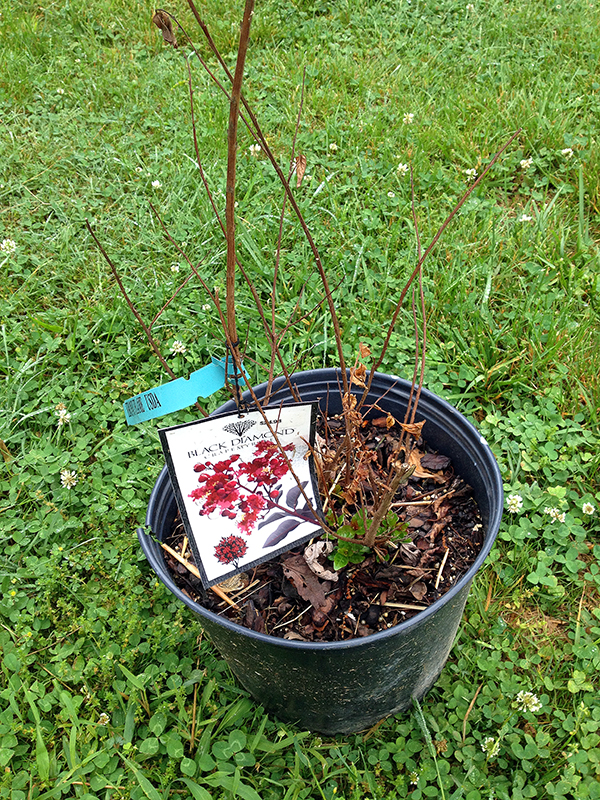
Seems reasonable until I tell you that I’d tortured this plant all last summer, letting it go bone dry and sunburned, as I prevaricated about where in the ground to stick it. And then summer became fall became our incredibly cold and snowy winter, all during which the pot of dead sticks sat unprotected outside of the wellhouse. I was disappointed in myself that I’d killed a perfectly good future tree by not being able to make a simple, timely decision, and just a few days ago I had accepted my crepe myrtle was toast and mentally pitched it on the compost pile.
But in that short interval between intention and action this forsaken plant had quietly, and on its own schedule, conveyed to me its plan to live.
Doing or not doing. Both are choices, and the joke of this choose-your-own-adventure is that we’re all just bumbling along. In a span of five minutes I got a perfect lesson in acting and not acting, and how each movement’s consequences can be both predictable and surprisingly unexpected.
I am going outside now to plant a crepe myrtle.
Happy progress in the streetside garden
May 20th, 2014 § 2
This spring, the garden I’ve been most impressed with is the one I have spent the least amount of time thinking about and fussing over. Isn’t that the way it is with so many things—just set the ball rolling, get out of the way and wait to be unexpectedly amazed?
The strip of garden that runs along the east side of the house was an afterthought in many ways, even though it is the garden closest to the road and should be a showpiece. When the house was built I threw some shrubs in to hold the soil on the bank—a few doublefile viburnums and some dwarf oakleaf hydrangeas, two of my favorite shrubs. Then last year I extended the garden by building the rock wall, and added some gift irises and a few more little plants as I bought them. Because there are no evergreens it looks pretty bare in winter, but this spring the bank erupted in what turned out, this year, to be a quite nice combination of bloom, leaf shape, and color variation. It’s a very old-fashioned feeling garden, with classic plants that one might find around Grandma’s country cottage.
The first to bloom are the the daffodils in late winter, and I am happy to see that their decaying foliage will soon be hid by the new growth coming in on the shrubs, just as it should be. I particularly love the variegated Solomon’s Seal (Polygonatum odoratum var. pluriflorum ‘Variegatum’) at lower right, below, with its white bell-like blooms and sturdy foliage that remains attractive all season.
The front corner is anchored by these nice catmints (Nepeta ‘Walker’s Low’), new last year, that continue the lavender bloom color begun by the iris.
The viburnums have finished their bloom, and the irises are soon to say goodbye. I have a few peonies, planted last spring to test if they liked this location, that are budding now. I will see how they look when they bloom, and if I like the effect I will add more peonies to continue the colorful blooms a few more weeks. That should take me until hydrangea time…but after that I will have to figure out what to add to maintain interest here through the dog days of summer until the hydrangeas change into their red leafed costumes for a fall display.
Next fall I will divide the Solomon’s Seal to spread bits of it through the whole garden, and to move it more forward of the shrubs. If I can find something low and pretty all season (maybe some kind of Ajuga, which has purple blooms at the same time as the iris?) to go right along the top of the rock wall, this will really shape up nicely—almost as if I planned it!
And then just when it looks awesome there’s a good chance the shrubs will have grown too large and it will be time to pull them out and start over!
As a way of explaining some of my happiness with this garden’s progress, check out what it looked like just a bit more than a year ago:
Seeing this photo it’s clear to me that I did the right thing by extending the garden to lessen the slope away from the house, which was making it hard to keep enough water on the shrubs to make them happy, and all the plants responded really well to the back-fill addition of forest-dug compost and a thick blanket of mulch. The border is deep enough (10 feet) that I am able to enjoy the show from inside the house, looking out through the windows, which is an aspect that is so enjoyable but that few consider when creating foundation plantings.
Still life
May 15th, 2014 § 1
Came across this scene in the middle of a gravel road during yesterday’s walk—a hawk kill? I think this bird’s claws, feet and legs are incredibly elegant.
I can’t figure out what kind of bird it is—its whole body was there, minus the head and innards, and it looked just like a tiny chicken complete with meaty thighs. It seemed much larger than our common songbirds, with a body of about seven or eight inches. It had some slightly barred feathers, which made me think maybe it’s some type of wood pecker? Or a yellow-bellied sapsucker? Any guesses?
State of the bonafide birds
May 12th, 2014 § 0
Last week most of my car trips included a chirping cardboard box riding shotgun. I delivered the chicks, which hatched in March, to their new owners. The little black pullet went to an acquaintance, a Wheaten Ameraucana pullet found a new and loving home with one of my Master Gardener friends, and the four Wheaten Ameraucana cockerels sold on CraigsList within an hour. Isn’t he handsome?
I kept two pullets. One is a pure Wheaten Ameraucana (in front below) and the other is a mystery hatched from a green egg out of a black mother! I love chickens at this age—about ten weeks—because they are sweet and curious, fully feathered but still small enough to pick up with one hand. They’re like little mini chicken pocket pets.
During the day I take the pullets out of their broody coop in the garage and put them in Tucker’s old puppy crate on the grass, and they eat their fill of clover, chickweed, whatever unfortunate bug comes along, and any grubs I unearth while digging in the garden. Last night they got to try pear for the first time.
I am a bit sad that chick season is drawing to a close. If I could, I’d raise chickens all year long. I don’t think I will ever get tired of watching eggs turn into bright-eyed, beautiful birds.
Speaking of which, Mr. and Mrs. Bluebird are busy with their brood of four in the bluebird box. It’s wonderful to be back in bluebird season.
And finally, on a less joyful note, the feisty broody hen that hatched this latest batch of chicks wasn’t feisty enough when I returned her to the main flock. Despite holding her own for two days, on the eve of her third day back I found her with a quarter-size hole torn in the back of her skull. In her pain and panic to get away from her attackers she actually jumped into my arms from the nesting box. It’s the exact same wound Oregano sustained under similar circumstances, though this hen’s is worse.
She’s been getting daily Bactine spray and Neosporin plus Blue-Kote spray (which dyes her wound purple). I wish that I would have stitched her wound when I found it. She keeps knocking it open and it’s taking a very long time to heal, having to close from the outside in across basically her entire skull. In fact it’s larger now than it is in this photo, which I took a couple of weeks ago.
She doesn’t act hurt and has returned to laying eggs. As long as her wound doesn’t get infected I will just keep what I am doing and let it heal itself. My experience with Cora taught me that chickens can recover from the most dramatic wounds. This little hen is protected within another dog crate within the main coop, and will be until she heals and can successfully reintegrate with the flock.
This is what she gets for successfully raising the offspring of her sister flock mates. The injustice!
Daily commute
May 11th, 2014 § 0
Beautiful bug: Rosy Maple Moth
May 10th, 2014 § 0
This cotton-candy confection of an insect is Rosy Maple Moth (Dryocampa rubicunda).
I found it, fittingly, on a maple tree in the front yard. Doesn’t even look real, does it?
A whole lot of construction going on
May 9th, 2014 § 3
It’s been a long time since I’ve subjected myself, my dad and the house to any interior construction projects. But now there’s wood filler dust coating every surface, I’m tripping over drills and saws and sanders, and my kitchen has looked like this for a week:
That’s 25 feet of good-time, fumey, oil painting fun, my friends. Stay tuned for the big reveal!
Happy day
May 8th, 2014 § 0
The day I buy the vegetables that will be the year’s summer garden is always a happy day. The first smell of crushed tomato leaves jolts awake some deeply-buried, winter-weary brain synapses and floods my entire body with relief and joy. When the tomatoes come out, winter’s really over. We made it through another one.
It’s hard to imagine it today when an entire garden’s worth of veg fits in the wheelbarrow, but in a couple of months these small plants will be pumping out enough produce to keep my family and me in good supply, with extra left over for freezing or friends.
That is, of course, if I am lucky and smart in my battle against innumerable insects, diseases, and weather. Growing pesticide-free food, at least in central Virginia, is a nonstop intellectual challenge, a chess game of anticipation and reaction. It’s never easy, but I suppose that’s why I keep doing it.
Let the games begin!
Bushogging the fields
May 7th, 2014 § 0
It’s been at least two years since I’ve bushogged the two sections of my property that I let grow wild. A neighbor used to cut hay off of these fields, but I decided I preferred to let the fields grow up and become better habitat for birds and little mammals. And, I love the color and texture of the dried broom straw, and how it interacts with light to provide an interesting middle ground in my photographs.
But landscape succession is an inescapable rule of nature, and in this part of the world open fields want to return to hardwood forest. The first pioneers are the brambles, and then come woodier plants such as native Eastern Red Cedars, sown by birds. There’s also some woody plant in the mix that resembles a quince in leaf shape and thorn, but doesn’t appear to flower.
Without mowing, an open field will become an impenetrable thicket in just a few years. It’s a beautiful and fascinating natural process, but not one I want so close to home. Some day I may want to run livestock in these fields, and cutting out the woody growth while it’s still small beats trying to clear it when the plants are much larger and more established.
So last weekend I spent the afternoon bushogging. I left several of the small cedars standing in the back field, thinking they might turn into pretty pasture trees some day. They might also obscure my mountain view, so they may come out further down the road. If I didn’t want to preserve the view I’d let as many as possible grow to create a windbreak to protect the north side of the house from the crazy-strong winds that scream down this valley.
It’s interesting to me how much cutting these fields changes the landscape around the house. Although mown fields look neater and tidier, I prefer the added visual interest of the uncut fields. I guess the good thing is it’s just grass, and it will grow back soon.




